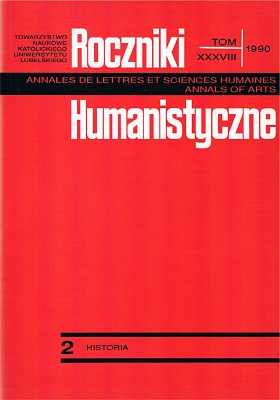The Patients of the Hospitals in Greater Poland in the 17th and 18th Centuries
Abstract
From the very moment of the conversion to Christianity the Church carried out a charitable activity on the basis of hospitals which she set up. In the Middle Ages as well as in the period of the 16th - 18th centuries they played first of all the function of poor-houses, and not infirmaries.
The phenomena of poverty, beggary and vagrancy constituted the most complicated and difficult socialproblems which could not be completely solved by establishing hospitals. Thus it turned out to be necessary to select the poor addmitted to hospitals. On the one hand, the question was how to provide care first for those who were most in need, and on the other, to cope with the so-called „false poor”, namely, people who were young, strong and healthy, and yet they begged under the disguise of poverty. To hospitals could be admitted only those who were unable to work, crippled, ill, old, particularly people from the parish where the hospital was. In the first thirty years of the 17th century barely every fifth parish of the Poznań diocese had a hospital within its territory. At the end of that century there were hospitals in circa half of the parishes in the diocese. Principally, the number of hospitals in the last quarter of the 17th century did not change throughout the 18th century. In the first half of the 17th century in all hospitals of that part of the Poznań diocese which belonged to Greater Poland there were at the same time ca 641 patients, but in the last quarter of the 17th century there were 569 poor people. In the first half of the 18th century the total number of the poor in hospitals dropped a little. In the period of 1724-1728 there were 567 people and in 1737-1744 only 461. The number of the „hospital inhabitants”, however, raised after the first partition, reaching 63. It was very characteristic of that period that the average number of patients in a hospital dropped successively. In the period of 1603-1611 on the average in particular hospitals of the archidiaconates in the Poznań diocese there were from 9 to 12 people, whereas throughout the 18th century the average number of people living in the hospitals of this diocese ranged from 4 to 6. The reason why the number of the poor in hospitals raised in the first half of the 17th century was due to the small number of hospitals. That is why they had to accomodate the greater number of the poor. As a rule the participation of women in the overall structure of patients ranged from 65 to 80 per cent. It was a very typical and common phenomenon in the Poznań diocese that the use of hospitals was inappropriate, which in turn contributed to the limited number of beds, and in consequence to a considerable fall in the number of patients who lived there. „Unlawful inhabitants” in hospitals constituted a very differentiated mosaic in view of their professional and social status. Most often the co-tenants of the patients were: organists and then hospital provosts. Hospital buildings were also let to schools. Furthermore one could encounter in hospitals: bailiffs, bell-ringers, teachers, and curates, people who served the Church, and even a Jew.
Copyright (c) 1990 Roczniki Humanistyczne

This work is licensed under a Creative Commons Attribution-NonCommercial-NoDerivatives 4.0 International License.





